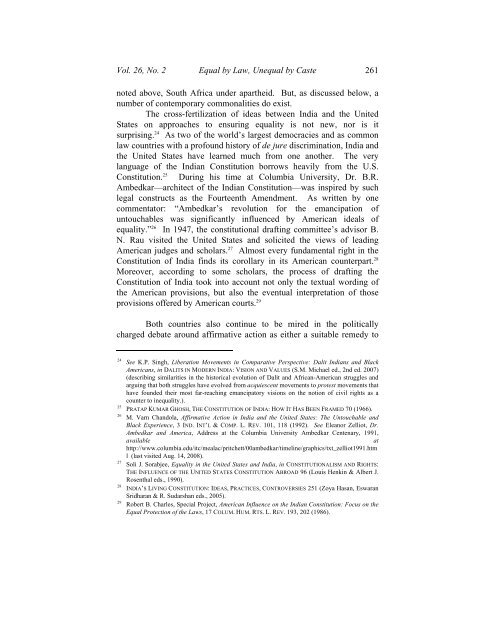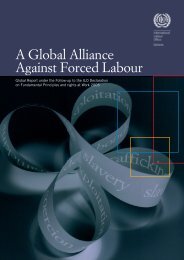260 Wisconsin <strong>International</strong> Law JournalThe Indian government has taken great pains to insulate itselffrom international scrutiny <strong>by</strong> repeatedly pointing out that this is notdiscrimination based on race, as though such confirmation nullifies theabuse in question. 17 Their protests ignore the fact that the prohibition of“racial discrimination” under international <strong>law</strong>, and in particular the<strong>International</strong> Convention on the Elimination of All Forms of RacialDiscrimination, Article 1, applies to discrimination on the basis ofdescent. 18 Regardless of how the abuse is defined, its noxious andpervasive character should be sufficient to invite international attentionand condemnation.Though scholars have pointed to the racial dimensions of <strong>caste</strong>,this is not a Black and White issue, or a clear Black and Brown issue.The <strong>caste</strong> system is one of graded in<strong>equal</strong>ity that invites people to sharein the spoils of iniquity even as they suffer from it. 19 By offeringindividuals a rank in a pecking order, the system strengthens itself andkeeps the <strong>equal</strong>ity revolution at bay.India is also an example of injustice in the extreme: the numbersaffected are greater, the poverty is deeper, the atrocities are an every dayaffair, and enforced servitude and segregation is the norm. Thepopulation of <strong>Dalit</strong>s <strong>equal</strong>s more than half the population of the UnitedStates. 20 A majority of <strong>Dalit</strong>s live on less than US$1 per day. 21 Everyweek, thirteen <strong>Dalit</strong>s are murdered and five <strong>Dalit</strong> homes are destroyed. 22Three <strong>Dalit</strong> women are raped and eleven <strong>Dalit</strong>s are assaulted everyday—a crime is committed against a <strong>Dalit</strong> every eighteen minutes. 23Aspects of the contemporary <strong>Dalit</strong> reality therefore find greaterresonance with the 1950s American South, American slavery, and, as17181920212223See, for example, the response of the Indian government to the U.N. Committee on theElimination of Racial Discrimination’s request that the government submit information on issuespertaining to Scheduled Castes and Scheduled Tribes. India’s periodic report stated that “‘<strong>caste</strong>’cannot be equated with ‘race’ or covered under ‘descent’ under Article 1 of the Convention.”Government of India, Fifteenth, sixteenth, seventeenth, eighteenth, and nineteenth periodicreports of the Republic of India, due on January 4, 1998, 2000, 2002, 2004, and 2006 submittedin one document on January 26, 2006, CERD/C/IND/19, 16 (Mar. 29, 2006).<strong>International</strong> Convention on the Elimination of All Forms of Racial Discrimination art. 1, Jan. 4,1969, 212 U.N.T.S. 216 (regarding descent).AMBEDKAR THOUGHT 74 (Pandiri Anjaiah & Durgam Subba Rao eds., 2005).The population of <strong>Dalit</strong>s in India is 167 million, while the population of the United States isaround 304 million. See U.S. Census Bureau, U.S. POPClock Projection, available at:http://www.census.gov/population/www/popclockus.html (last visited Aug. 14, 2008).SMITA NARULA, BROKEN PEOPLE: CASTE VIOLENCE AGAINST INDIA’S “UNTOUCHABLES” 2(Human Rights Watch, 1999) [hereinafter BROKEN PEOPLE].See infra note 285.Id.
Vol. 26, No. 2 Equal <strong>by</strong> Law, Un<strong>equal</strong> <strong>by</strong> Caste 261noted above, South Africa under apartheid. But, as discussed below, anumber of contemporary commonalities do exist.The cross-fertilization of ideas between India and the UnitedStates on approaches to ensuring <strong>equal</strong>ity is not new, nor is itsurprising. 24 As two of the world’s largest democracies and as common<strong>law</strong> countries with a profound history of de jure discrimination, India andthe United States have learned much from one another. The verylanguage of the Indian Constitution borrows heavily from the U.S.Constitution. 25 During his time at Columbia University, Dr. B.R.Ambedkar—architect of the Indian Constitution—was inspired <strong>by</strong> suchlegal constructs as the Fourteenth Amendment. As written <strong>by</strong> onecommentator: “Ambedkar’s revolution for the emancipation ofuntouchables was significantly influenced <strong>by</strong> American ideals of<strong>equal</strong>ity.” 26 In 1947, the constitutional drafting committee’s advisor B.N. Rau visited the United States and solicited the views of leadingAmerican judges and scholars. 27 Almost every fundamental right in theConstitution of India finds its corollary in its American counterpart. 28Moreover, according to some scholars, the process of drafting theConstitution of India took into account not only the textual wording ofthe American provisions, but also the eventual interpretation of thoseprovisions offered <strong>by</strong> American courts. 29Both countries also continue to be mired in the politicallycharged debate around affirmative action as either a suitable remedy to242526272829See K.P. Singh, Liberation Movements in Comparative Perspective: <strong>Dalit</strong> Indians and BlackAmericans, in DALITS IN MODERN INDIA: VISION AND VALUES (S.M. Michael ed., 2nd ed. 2007)(describing similarities in the historical evolution of <strong>Dalit</strong> and African-American struggles andarguing that both struggles have evolved from acquiescent movements to protest movements thathave founded their most far-reaching emancipatory visions on the notion of civil rights as acounter to in<strong>equal</strong>ity.).PRATAP KUMAR GHOSH, THE CONSTITUTION OF INDIA: HOW IT HAS BEEN FRAMED 70 (1966).M. Varn Chandola, Affirmative Action in India and the United States: The Untouchable andBlack Experience, 3 IND. INT’L & COMP. L. REV. 101, 118 (1992). See Eleanor Zelliot, Dr.Ambedkar and America, Address at the Columbia University Ambedkar Centenary, 1991,availableathttp://www.columbia.edu/itc/mealac/pritchett/00ambedkar/timeline/graphics/txt_zelliot1991.html (last visited Aug. 14, 2008).Soli J. Sorabjee, Equality in the United States and India, in CONSTITUTIONALISM AND RIGHTS:THE INFLUENCE OF THE UNITED STATES CONSTITUTION ABROAD 96 (Louis Henkin & Albert J.Rosenthal eds., 1990).INDIA’S LIVING CONSTITUTION: IDEAS, PRACTICES, CONTROVERSIES 251 (Zoya Hasan, EswaranSridharan & R. Sudarshan eds., 2005).Robert B. Charles, Special Project, American Influence on the Indian Constitution: Focus on theEqual Protection of the Laws, 17 COLUM. HUM. RTS. L. REV. 193, 202 (1986).
- Page 1 and 2: EQUAL BY LAW, UNEQUAL BY CASTE: THE
- Page 3 and 4: Vol. 26, No. 2 Equal by Law, Unequa
- Page 5: Vol. 26, No. 2 Equal by Law, Unequa
- Page 9 and 10: Vol. 26, No. 2 Equal by Law, Unequa
- Page 11 and 12: Vol. 26, No. 2 Equal by Law, Unequa
- Page 13 and 14: Vol. 26, No. 2 Equal by Law, Unequa
- Page 15 and 16: Vol. 26, No. 2 Equal by Law, Unequa
- Page 17 and 18: Vol. 26, No. 2 Equal by Law, Unequa
- Page 19 and 20: Vol. 26, No. 2 Equal by Law, Unequa
- Page 21 and 22: Vol. 26, No. 2 Equal by Law, Unequa
- Page 23 and 24: Vol. 26, No. 2 Equal by Law, Unequa
- Page 25 and 26: Vol. 26, No. 2 Equal by Law, Unequa
- Page 27 and 28: Vol. 26, No. 2 Equal by Law, Unequa
- Page 29 and 30: Vol. 26, No. 2 Equal by Law, Unequa
- Page 31 and 32: Vol. 26, No. 2 Equal by Law, Unequa
- Page 33 and 34: Vol. 26, No. 2 Equal by Law, Unequa
- Page 35 and 36: Vol. 26, No. 2 Equal by Law, Unequa
- Page 37 and 38: Vol. 26, No. 2 Equal by Law, Unequa
- Page 39 and 40: Vol. 26, No. 2 Equal by Law, Unequa
- Page 41 and 42: Vol. 26, No. 2 Equal by Law, Unequa
- Page 43 and 44: Vol. 26, No. 2 Equal by Law, Unequa
- Page 45 and 46: Vol. 26, No. 2 Equal by Law, Unequa
- Page 47 and 48: Vol. 26, No. 2 Equal by Law, Unequa
- Page 49 and 50: Vol. 26, No. 2 Equal by Law, Unequa
- Page 51 and 52: Vol. 26, No. 2 Equal by Law, Unequa
- Page 53 and 54: Vol. 26, No. 2 Equal by Law, Unequa
- Page 55: Vol. 26, No. 2 Equal by Law, Unequa
- Page 58 and 59:
312 Wisconsin International Law Jou
- Page 60 and 61:
314 Wisconsin International Law Jou
- Page 62 and 63:
316 Wisconsin International Law Jou
- Page 64 and 65:
318 Wisconsin International Law Jou
- Page 66 and 67:
320 Wisconsin International Law Jou
- Page 68 and 69:
322 Wisconsin International Law Jou
- Page 70 and 71:
324 Wisconsin International Law Jou
- Page 72 and 73:
326 Wisconsin International Law Jou
- Page 74 and 75:
328 Wisconsin International Law Jou
- Page 76 and 77:
330 Wisconsin International Law Jou
- Page 78 and 79:
332 Wisconsin International Law Jou
- Page 80 and 81:
334 Wisconsin International Law Jou
- Page 82 and 83:
336 Wisconsin International Law Jou
- Page 84 and 85:
338 Wisconsin International Law Jou
- Page 86 and 87:
340 Wisconsin International Law Jou
- Page 88 and 89:
342 Wisconsin International Law Jou
















